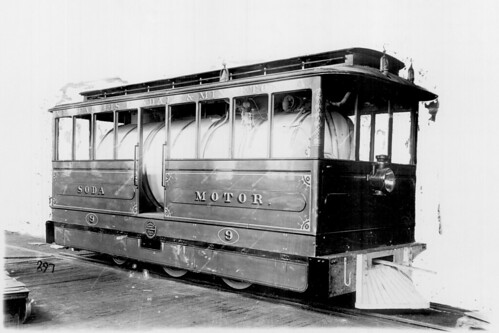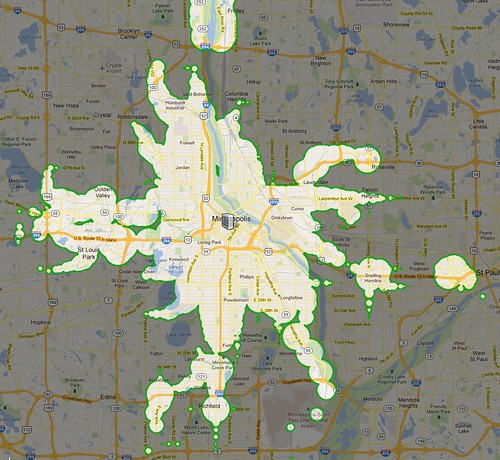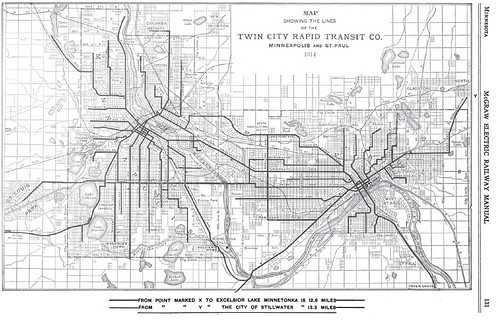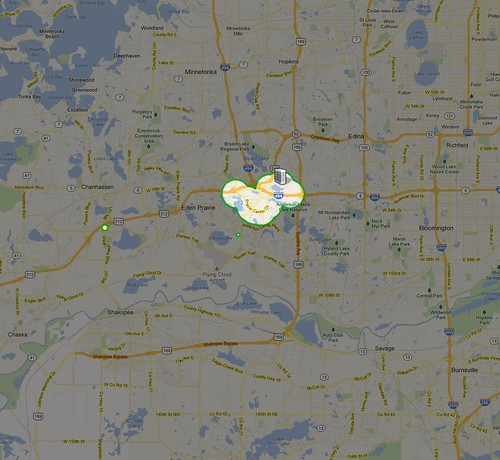Minnescraper, the main forum for news and gossip about local urban design and transportation topics, has returned from the dead, at least for a little while. Something has gone wrong with the database, possibly due to disk space issues. One of the moderators went in and deleted some old messages, which apparently cleared up enough space for it to start working again, though the always-hot thread about the Vikings Stadium is still broken (not that I mind at this point... I'd rather not talk about it).
The primary site administrator has a life these days and hasn't had a chance to look into the problem in depth.
Covering rail projects along the Twin Cities – Milwaukee – Chicago Corridor, and delving into the history of the Hiawathas, Zephyrs, and 400s which raced through this region in excess of 100 mph in the 1930s, '40s, and '50s.
Tuesday, May 29, 2012
Friday, May 18, 2012
The Motor Line and its fireless soda locomotives

A Baldwin "soda motor" for the Minneapolis, Lyndale, and Minnetonka Railway.
One strange technology that gets mentioned in passing in histories of the Twin Cities streetcar network is the "soda motor". When I first read about it, I was sure it must have just been a play on words: soda must have come from the tail end of Minnesota, right? Further reading explained that no, it really refers to sodium hydroxide, commonly known as caustic soda or lye—not something I'd want to spend any time close to if I could avoid it. But it really did get used here, even if the 'Sota / soda similarity seems a bit punny.
The Minneapolis, Lyndale, and Minnetonka Railway was built in part to capitalize on tourist traffic heading from Minneapolis to Lake Calhoun, Lake Harriet, and eventually Lake Minnetonka. Their line ran from downtown Minneapolis along Marquette and Nicollet Avenues to 31st Street South, where it turned west until reaching Lake Calhoun. From there, it used a largely private right-of-way to run to Lake Harriet and eventually out to Excelsior on Lake Minnetonka.
The railroad started out in 1879 with one conventional steam locomotive and two "steam motors" which were small locomotives wrapped in streetcar-style shells—reportedly to help prevent horses from being frightened as trains ran along city streets (the city had ordinances against running conventional locomotives on streets as well).
Because of the steam motors, the ML&M was nicknamed the "Motor Line". They were able to sustain operation for a while, but unfortunately the company had been the fourth and last railroad to reach Lake Minnetonka and were never very financially stable. There was also an ever-increasing push to get steam-powered vehicles off the streets of Minneapolis, whether they looked like streetcars or not.
In December 1885, the Motor Line began experimenting with electrification using a system from Charles Van Depoele, but electrified traction had not yet matured enough by that time. The electric motors in the initial vehicles vibrated badly and there were other mechanical problems showing that electrification wasn't quite ready for prime time.
In 1886, the railroad began running soda motors manufactured by Baldwin Locomotive Works in Philadelphia, reportedly the first (and possibly the only) such engines to be built in the United States, it seems that others may have been imported previously for use along elevated rail lines in New York City. European railroads had been experimenting with them for some time, and it seemed they might have been a way to deal with tunnels without filling those limited air spaces with noxious exhaust. Articles on the experiments of a Mr. Honigmann near Berlin, Germany were described in the British journal Engineering and in Scientific American in 1885.
An article on Honigmann's locomotives from the British journal "Engineering".
The idea of a soda motor conjures up childhood memories of baking-soda volcanoes: Mix baking soda with vinegar, gases get produced, and in seconds the mixture bubbles up and overflows its container. However, while these locomotives mixed soda and a liquid (water), they didn't use gas directly generated by chemical reactions, but rather operated by capturing the heat that was generated.
Caustic soda is exothermic when it comes in contact with water. Given a large enough quantity, this soda and water solution can generate enough heat to boil water and produce steam. Instead of having a firebox filled with coal or another fuel to heat up a boiler, soda locomotives had boilers jacketed with a container filled with sodium hydroxide (or other salts in some cases). The heated soda caused steam to be generated in the boiler, the steam was fed through pistons to provide propulsion, and then the condensing steam was fed through the soda to cause more heat to be produced.
This normally operated in a closed loop, so no steam was escaping the engine during operation (a side-effect being that the engines were practically silent). Only when boiler temperature reached high enough levels where the soda solution itself began to boil would steam be let off. However, operating a soda locomotive was a race against time: Eventually, the sodium hydroxide would become saturated and wouldn't generate enough heat to produce more steam. Nonetheless, these locomotives were able to operate for hours at a time before being brought back to home base to be recharged.
At the end of operation, a stationary boiler (likely installed at the railroad's roundhouse, the site of today's Nicollet Garage) would be hooked up to the engine and feed superheated steam through the soda solution, boiling off the water, leaving more or less solid sodium hydroxide, and allowing the process to start all over again.
Clearly this wasn't the most efficient process. According to the 1885 reports on Honigmann's locomotives, the soda motors only produced about 60% as much steam per unit of coal as traditional locomotives did, though the stationary boilers could be run on cheaper, lower-quality coal than their mobile counterparts and (at least theoretically) didn't require as many employees to run.
Still, the prospect of an exploding soda motor spewing (literally) tons of boiling-hot caustic material around a neighborhood means that it was probably good that the technology never really caught on. Minneapolis passed an ordinance in 1887 which banned the soda motors. Van Depoele had apparently continued work on making electric traction more reliable on the line, but unfortunately the company had gone bankrupt. It quickly came under the control of Thomas Lowry's Minneapolis Street Railway, and within a few years the entire streetcar network in the Twin Cities was electrified.
Thursday, May 10, 2012
Washout near Le Sueur, Minnesota
The Trains magazine News Wire reports that there's been a washout of Union Pacific tracks near Le Sueur, Minnesota. The segment of track is part of the Mankato Subdivision. Apparently about half a mile of track will have to be repaired. Traffic is being rerouted along the ex-Rock Island "Spine Line" farther east.
Friday, May 4, 2012
Sprawl and the Big Crunch
Another column for streets.mn.
Almost all of us are guilty of living sprawling lifestyles, either now or in the past. Sprawl is a huge urban planning problem, but it's a difficult one to handle simply because it's so prevalent. There's little will to change when everyone shares part of the blame, but we must find ways to do so in order to help deal with the challenge of climate change and changes in the cost and availability of energy sources.
Finding ways to deal with urban/suburban sprawl isn't helped by the fact that it's difficult to define in the first place. Sure, city dwellers deride the suburbs for their common cul-de-sacs and curvilinear streets, but even the scale of our central cities is pretty vast—Minneapolis itself stretches 11 miles north to south, a distance which would take 3 to 4 hours to traverse on foot. Saint Paul is almost as wide east to west. By bicycle or public transportation, that would typically take an hour to 90 minutes, about three times the average one-way travel time for a car commuter in our area.
I'm sure it happens all the time: A car commuter grows weary of his or her commute, but is confronted with a stark reality when they look up the bus journey on metrotransit.org or a mapping site—The trip will take 3 to 4 times as long as it would by car, if it can be done at all. The reaction is often to blame the bus or the train. Clearly something is wrong with the system!
Well, sort of. It's true that public transportation can and should be sped up and expanded, but there are some inherent limits to the technology. A bus or train running at the same top speed as a car will never be able to reach the same end-to-end speed because of the number of stops made in between. The only ways to get public transportation to be competitive for end-to-end travel time is to increase the top speed, leapfrog over potential intermediate stops, and/or make extensive use of exclusive transitways to bypass congestion. Each of these has trade-offs, such as increasing expense, reducing potential ridership, and sometimes taking property through eminent domain.
Sprawl is the real reason why it's often impractical to switch a car trip to a train, bus, or bike ride. Most of us make daily demands of our transportation networks that are illogical (and sometimes those demands are made by others upon us). If the car never came along, our cities would be much more compact. People would most likely still travel about the same amount of time each day to work, learn, or shop, but transportation through slower methods would have limited outward growth and encouraged building up rather than out.
Travelers to cities outside the U.S. often remark about how fast and efficient transit networks are in other countries, but in reality, they're often not any faster than what we have here. In reality, they're simply seeing the effects of a more compact geography, amplified by the fact that tourist attractions are also centrally-located a lot of the time. There isn't just a greater population density, there's also a greater density of places where people want to go.
The same used to be the case here during much of the streetcar era. While the Twin City Rapid Transit system famously extended from Lake Minnetonka in the west to Stillwater in the east, the core of the system barely extended past the borders of Minneapolis and Saint Paul themselves. In an accident of history, the borders of he core cities roughly correspond with 30-minute travel times to the respective downtowns.
Now, the car is never going to go away, and many people will fight long and hard to keep their hands on the steering wheel. However, I'm convinced that they're at or near a peak in this country and will become much less popular in future decades. Fuel prices will rise and the everlasting push for safer and more efficient cars will keep making the vehicles themselves more expensive. Along with direct costs are moral and ethical issues—externalities ranging from direct and indirect pollution from CO2 and other pollutants, altered landscapes in places like the Alberta tar sands, and violence and economic impacts on people elsewhere in the world. Changing over to renewable energy sources will help, but it's unlikely to cover our current needs.
Moving away from car-based transportation requires us to shift our population around and change where we place businesses, schools, and other amenities. In the Twin Cities, these shifts almost certainly have to be toward the core of our region, because Minneapolis and Saint Paul themselves are much more walkable, bikeable, and transitable than anywhere else, and that's where the existing and future investments are most sustainable.
Some suburbs will certainly see improved transit mobility in the future, but job and population centers are so dispersed that a transit system that attempted to serve all of them would probably collapse under its own weight. Some communities are going to have to get by with minimal transit access and instead build more exclusively around the idea of getting around on foot and by bike. Pick a spot and turn it into a real town center.
We're going to go through a Big Crunch as car ownership rates decline and more people seek out transit-rich environments that have jobs and the amenities of daily life in close proximity. The population won't tolerate trip times tripling or quadrupling in length, so communities out on the edge must plan to become denser and more connected, or they'll be left behind as populations move elsewhere.
Almost all of us are guilty of living sprawling lifestyles, either now or in the past. Sprawl is a huge urban planning problem, but it's a difficult one to handle simply because it's so prevalent. There's little will to change when everyone shares part of the blame, but we must find ways to do so in order to help deal with the challenge of climate change and changes in the cost and availability of energy sources.
Finding ways to deal with urban/suburban sprawl isn't helped by the fact that it's difficult to define in the first place. Sure, city dwellers deride the suburbs for their common cul-de-sacs and curvilinear streets, but even the scale of our central cities is pretty vast—Minneapolis itself stretches 11 miles north to south, a distance which would take 3 to 4 hours to traverse on foot. Saint Paul is almost as wide east to west. By bicycle or public transportation, that would typically take an hour to 90 minutes, about three times the average one-way travel time for a car commuter in our area.
I'm sure it happens all the time: A car commuter grows weary of his or her commute, but is confronted with a stark reality when they look up the bus journey on metrotransit.org or a mapping site—The trip will take 3 to 4 times as long as it would by car, if it can be done at all. The reaction is often to blame the bus or the train. Clearly something is wrong with the system!
Well, sort of. It's true that public transportation can and should be sped up and expanded, but there are some inherent limits to the technology. A bus or train running at the same top speed as a car will never be able to reach the same end-to-end speed because of the number of stops made in between. The only ways to get public transportation to be competitive for end-to-end travel time is to increase the top speed, leapfrog over potential intermediate stops, and/or make extensive use of exclusive transitways to bypass congestion. Each of these has trade-offs, such as increasing expense, reducing potential ridership, and sometimes taking property through eminent domain.
Sprawl is the real reason why it's often impractical to switch a car trip to a train, bus, or bike ride. Most of us make daily demands of our transportation networks that are illogical (and sometimes those demands are made by others upon us). If the car never came along, our cities would be much more compact. People would most likely still travel about the same amount of time each day to work, learn, or shop, but transportation through slower methods would have limited outward growth and encouraged building up rather than out.
Travelers to cities outside the U.S. often remark about how fast and efficient transit networks are in other countries, but in reality, they're often not any faster than what we have here. In reality, they're simply seeing the effects of a more compact geography, amplified by the fact that tourist attractions are also centrally-located a lot of the time. There isn't just a greater population density, there's also a greater density of places where people want to go.
The same used to be the case here during much of the streetcar era. While the Twin City Rapid Transit system famously extended from Lake Minnetonka in the west to Stillwater in the east, the core of the system barely extended past the borders of Minneapolis and Saint Paul themselves. In an accident of history, the borders of he core cities roughly correspond with 30-minute travel times to the respective downtowns.
Now, the car is never going to go away, and many people will fight long and hard to keep their hands on the steering wheel. However, I'm convinced that they're at or near a peak in this country and will become much less popular in future decades. Fuel prices will rise and the everlasting push for safer and more efficient cars will keep making the vehicles themselves more expensive. Along with direct costs are moral and ethical issues—externalities ranging from direct and indirect pollution from CO2 and other pollutants, altered landscapes in places like the Alberta tar sands, and violence and economic impacts on people elsewhere in the world. Changing over to renewable energy sources will help, but it's unlikely to cover our current needs.
Moving away from car-based transportation requires us to shift our population around and change where we place businesses, schools, and other amenities. In the Twin Cities, these shifts almost certainly have to be toward the core of our region, because Minneapolis and Saint Paul themselves are much more walkable, bikeable, and transitable than anywhere else, and that's where the existing and future investments are most sustainable.
Some suburbs will certainly see improved transit mobility in the future, but job and population centers are so dispersed that a transit system that attempted to serve all of them would probably collapse under its own weight. Some communities are going to have to get by with minimal transit access and instead build more exclusively around the idea of getting around on foot and by bike. Pick a spot and turn it into a real town center.
We're going to go through a Big Crunch as car ownership rates decline and more people seek out transit-rich environments that have jobs and the amenities of daily life in close proximity. The population won't tolerate trip times tripling or quadrupling in length, so communities out on the edge must plan to become denser and more connected, or they'll be left behind as populations move elsewhere.
Subscribe to:
Posts (Atom)


